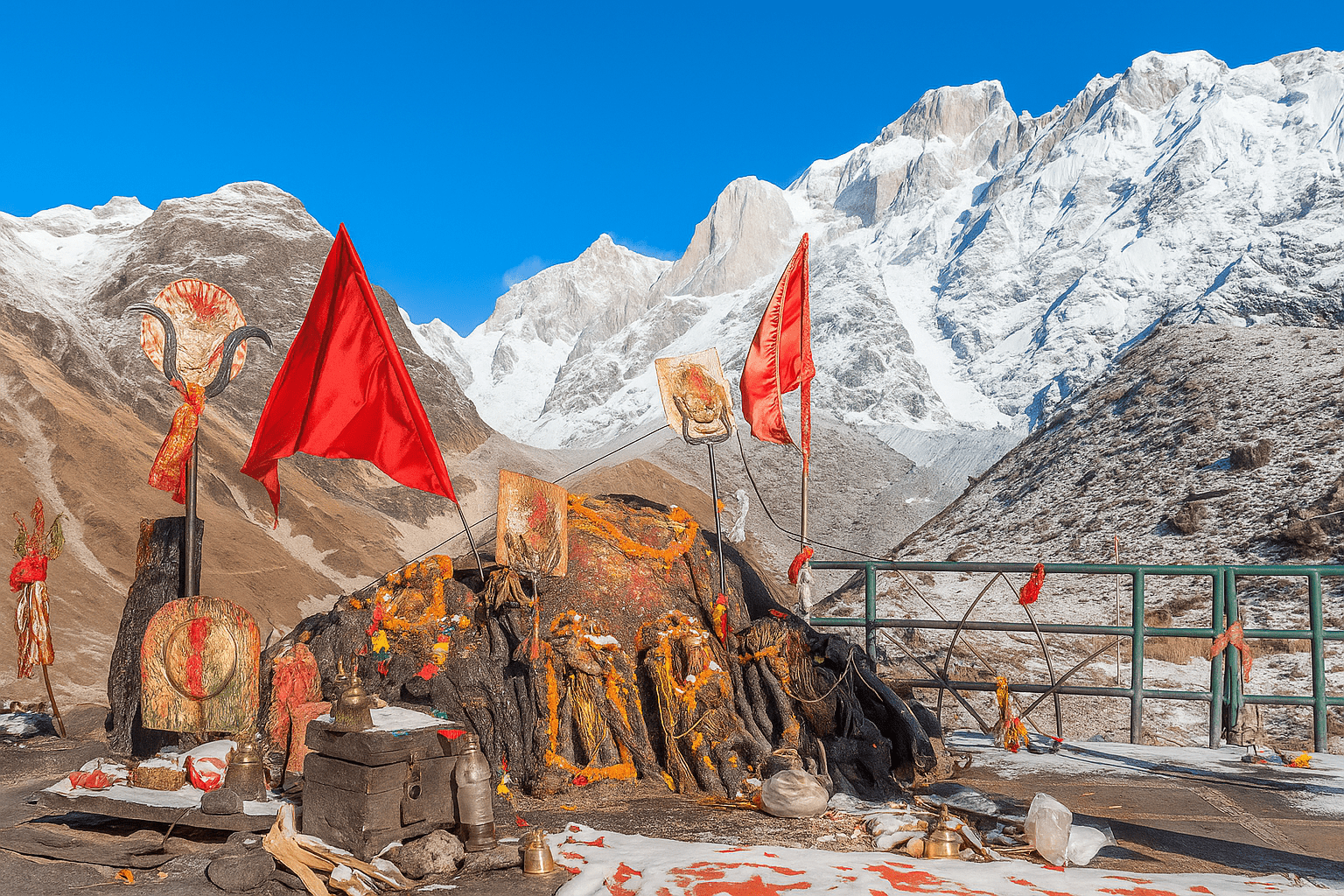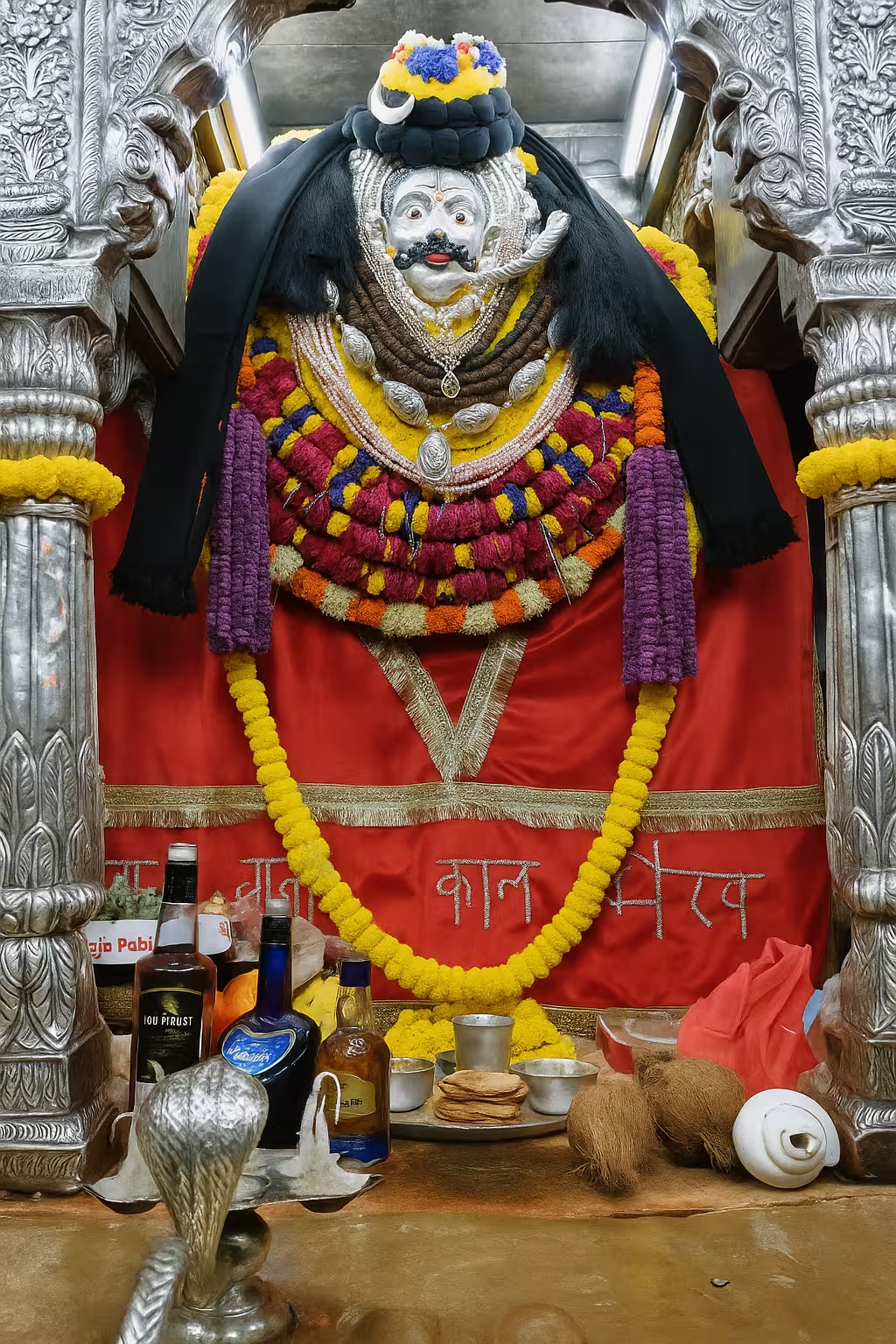Baba Kaal Bhairav: The Eternal Guardian of Kashi
The sacred city of Kashi (Varanasi) lies a powerful spiritual presence feared and revered alike — Baba Kaal Bhairav, the Eternal Guardian of Kashi. Known as the Kotwal (chief protector or police) of this ancient city, Baba Kaal Bhairav is not a ordinary deity. He is a one of Shiva’s Form Who detroyed evil and protect from injustice.
In Kashi, where spiritual wisdom flows like the holy Ganga, Baba Kaal Bhairav serves as the celestial watchman who protects the land from negativity, maintains order, and grants liberation from fear. To every soul that steps into this spiritual city, his presence is essential. In fact, it is widely believed that no one can stay in Kashi without his permission.
Let us dive into the mysticism, history, rituals, and spiritual importance of Baba Kaal Bhairav, the Eternal Guardian of Kashi.
The Fierce Form of Shiva: Who is Baba Kaal Bhairav?
Baba Kaal Bhairav is one of the fiercest and most mysterious manifestations of Lord Shiva. Meaning of Kaal Bhairav is “Kaal” means time or death, and “Bhairav” means terror. Together, Kaal Bhairav is the Lord of Time and Death — one who destroys ignorance, ego, and evil forces.
Unlike the calm and meditative image of Shiva that most people are familiar with, Kaal Bhairav’s form is awe-inspiring and fearsome. Clad in black, adorned with a garland of skulls, and riding a black dog, he holds a trident and skull in his hands. His very image inspires both awe and surrender.
He is not a god to be feared, but one to be deeply respected — for he protects, punishes, and purifies.
The Legend of Kaal Bhairav: How the Guardian Was Born
The Story of Kaal Bhairav is mentioned in many scriptures, especially in the Shiva Purana. According to Purans, there was once a dispute among the Lord Brahma (the creator), Lord Vishnu (the preserver), and Lord Shiva (the destroyer) about who was the supreme deity between them. Lord Brahma arrogantly claimed superiority and even insulted Lord Shiva.
In response, Lord Shiva created Kaal Bhairav, a fierce form to punish Brahma’s arrogance.In a flash of rage, Kaal Bhairav cut off one of Brahma’s five heads, thus bringing him back to humility.
Killing a Brahma or a Brahmin was a great sin (Brahmahatya). For this incident, Kaal Bhairav wandered across the earth as a beggar, carrying Brahma’s skull as his begging bowl. His redemption came only when he reached Kashi, where the skull finally fell to the ground, and he was freed from sin.
At that moment, Shiva declared that Kaal Bhairav would remain in Kashi forever, acting as the Eternal Guardian of the city. He would protect its people, punish evil, and ensure spiritual order.
Kotwal of Kashi: A Divine Protector
Kashi is not just a city — it is a living, breathing tirtha (sacred place) where the soul is believed to attain moksha. In this holy city, Baba Kaal Bhairav is the Kotwal who ensures justice and dharma.
It is believed that:
No one can enter or leave Kashi without Baba’s permission. Even Lord Shiva’s blessings are incomplete without visiting Kaal Bhairav first. Every soul who wishes to attain moksha in Kashi must first seek the blessing of Kaal Bhairav.
He is the protector of saints, sadhus, pilgrims, and residents of the Kashi city. People believe that evil spirits, curses, or negative energies cannot touch them when under Baba’s Kaal Bhairav protection.
The Kaal Bhairav Temple: Power and Presence
The Kaal Bhairav Temple in Kashi is one of the most powerful and important temples in the city. Located in the Vishweshwarganj area, it is surrounded by bustling bazaars and age-old houses. The temple’s architecture is humble, but the energy inside is electrifying.
Inside the temple,
A fierce black-faced idol of Baba Kaal Bhairav, partially hidden and draped in cloth. The deity’s vehicle, a black dog, represented in sculptures and carvings. Constant chants of “Baba Kaal Bhairav ki Jai!” as devotees stream in to seek blessings.
Devotees offers Baba Kaal Bhairav liquor, black thread, mustard oil lamps, and flowers.
Offering Liquor to Baba Kaal Bhairav unique tradition here. Devotees bring new Liquor bottles, and a few drops are offered to the Baba Kaal Bhairav by the priest. This symbolizes surrendering one’s ego, desires, and impurities.
Rituals and Devotion: How to Worship Baba Kaal Bhairav
Worshipping Baba Kaal Bhairav is done with simplicity but deep faith. Here are common rituals and beliefs:
- Black Thread Ritual
Devotees purchase black thread from the temple and tie it on their wrist to seek protection from negative energies, diseases, and evil eyes. - Offering Liquor
Liquor is offered at the shrine as a mark of humility and devotion. Devotees believe this helps in removing bad karma. - Lighting Mustard Oil Lamps
Lighting deepams (lamps) of mustard oil is a traditional offering to Kaal Bhairav to remove inner darkness and fear. - Chanting Kaal Bhairav Ashtakam
This powerful hymn composed by Adi Shankaracharya praises the glory of Kaal Bhairav and is recited to invoke strength and blessings. - Visiting on Sundays and Tuesdays
These days are especially auspicious for Kaal Bhairav worship. Large crowds gather to seek his protection and offer prayers.
Spiritual Benefits of Baba Kaal Bhairav’s Blessings
Devotees who worship Baba Kaal Bhairav with sincerity often experience:
Freedom from fear and anxiety
Protection from black magic and evil spirits
Success in legal matters and court cases
Healing from chronic illness and mental stress
Confidence and mental clarity
Inner spiritual awakening and peace
His grace is considered immediate and powerful. Many devotees share stories of how Baba helped them through tough times, illness, or injustice.
Connection with Aghora and Tantra
Kaal Bhairav holds a special place in Tantric and Aghora traditions. For seekers walking the path of Tantra, he represents the master of occult powers (siddhis) and protector of sacred knowledge.
Aghoris and sadhus often meditate near cremation grounds, invoking Baba’s blessings for spiritual liberation. He is considered the gatekeeper of inner consciousness and the destroyer of illusions.
This intense connection with death, transformation, and truth makes Kaal Bhairav worship both deeply mystical and liberating.
Kaal Bhairav Jayanti: Celebrating His Birth
Kaal Bhairav Jayanti is the holy day . It falls on the Ashtami Tithi (eighth day) of Krishna Paksha in the month of Margashirsha (usually November or December).
On this day:
Devotees observe fasts.
Special pujas and havans are performed at the temple.
Thousands devotees gathered at the Kaal Bhairav Temple in Kashi to offer prayers.
Mantras and hymns are chanted all night.
The energy in the temple is unmatched, as devotees seek blessings to overcome obstacles, fears, and karmic debts.
Kashi and Kaal Bhairav: A Bond Beyond Time
Kashi is said to be older than history, older than tradition — an eternal city where life and death dance together in harmony. And in this divine place, Baba Kaal Bhairav stands tall as the Eternal Guardian.
He is not just a temple deity. He is time itself.He is the protector of devotees, Saints & Sadhus, the fearless remover of fear, and the liberator of souls. No pilgrimage to Kashi is complete without his darshan.
Whether you come with suffering, motive, or loyality, Baba Kaal Bhairav welcomes you with silent, strength and leaves you transformed.
Baba Kaal Bhairav: The Eternal Guardian of Kashi is more than just a fierce idol. He is the guardian of one of the holiest cities on earth. He watches over every pilgrim, every sadhu, every soul seeking freedom. In his fierce form lies boundless compassion.In his fierce form lies boundless compassion. In his terrifying gaze lies divine justice.
For those who seek fearlessness, truth, and freedom from the cycle of life and death, Baba Kaal Bhairav is not just a deity — he is the path and the protector.


